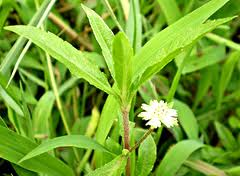Table of Contents
BHRNGARAJA
Eclipta alba – Ayurvedic Herb

Caraka Indicated it for Raktapitta while vagbhata advocated Its consumption for one month to have the Rasayana effect.
Paraskara grhyasutra, kesava paddhati, soundkiya Atharva, Kousika sathra etc delineate Bhrngaraja for its cosmetic as well as medicinal value.
In Raja nigantu the blue variety is claimed to be the best Rasayana.
VARIETIES
According to Nighantukara.
- Sveta – Eclipta alba Hassk
- Pita – Wedalia Celendulaceae Less1
- Krsna or Nila
Botanically two varieties
- Eclipta alba Hassk
- Wedalia Calendulaceae
SYNONYMS AND INTERPRETATION
Bhrngaraja / Brnga : The Plant is attracted by bees and wasps.
Markava : That which relieves the disease of hairs or greying of hairs.
Angaraka : Name of the plant Bhrngaraja.
Kesaraja : A good drug for hairs.
Kesaranjana : That which colours the hair.
Bhrngaraka: The plant Bhrngaraja
Pankajatha: Grows in Marshy places.
Mahaneela: A variety of Bhrngaraja.
Ravi Priya : The plant prefers sunlight.
Sooryavarta: Grows in the direction of sun.
Bhrngarenu: The pollens are transmitted by bees and wasps.
VERNACULAR NAMES
- Hindi – Bhangaraja
- Kannada – Ajaagara
- Malayalam – Jala Bhangara
- Telugu – Galagara
- Tamil – Kayanthakara
- Marathi – Maka
- Gujarath – Bhangara
- Punjabi – Bhangra
- Bengali – Kesuriya
PARTS USED
Whole plant
DOSAGE
Swarasa – 5 to 10 ml
Beeja curna – 1 to 3 gms
Kwatha – 13 to 36 gms
CHEMICAL COMPOSITION
Plant: Resin
Alkaloid Ecliptine
Leaves: Leucine
Isoleucine
Valine
Phenybalmine
Methionine
Glycine Glutamine
Glutamic acid
Cystone
Methionine
PROPERTIES AND DOSHAGNATHA
Rasa – Katu, Tikta
Guna – ruksa, Laghu
Virya – Usna
Vipaka – Katu
Dosakarma – Kaphavata samaka
KARMA
- Kapha- Vata Hara
- Kesya
- Rasayana
- Balya
- Caksusya
- Dantya
PRAYOGA
- Pandu
- Kamala
- Svasa
- Kasa
- Netra roga
- Hridroga
- Krimi
- Kustha
- Sirah sula
THERAPEUTIC USES
- Garbhasthapana – cow milk with equal quantity of Bhrngaraja svarasa should be given to pregnant women.
- Svitra – Bhrngaraja is fried with oil in an iron vessel is consumed and after that milk boiled with Bijaka shall be given as Anupana.
- The taila prepared from Bhrngaraja is used as kesya, in sirasula, palitya etc.
- In children 1 to 2 drops of swarasa is given with honey to relieve kasa.
- For improving eye sight , tila taila and Bibhilaka oil cooked with Bhrngaraja juice.
OTHER THAN MEDICAL USE
- A black dye is obtained from the plant it is used as a hair dye,
- It is used for tattooing.
FOLKLORE
- The leaf juice applied along with honey is a popular remedy for catarrh in infants.
- A preparation obtained from the leaf juice boiled with sesame or coconut oil is used for anointing the head to render the hair black and luxuriant.
- Plant is rubbed with a little oil for relieving head ache and with sesame oil in elephantiasis .
- Root of eclipta alba are emetic and purgative.
- The leaf extract is considered to be powerful liver tonic,
- Ecliptic alba also has traditional external uses like athlete foot, eczema and dermatitis.
- Leaves have been used in the treatment of scorpion stings.
RESEARCH WORKS
- The Alcoholic extract of the plant has been reported to have antiviral activity against Ranikhet disease virus. (Dhar et al. 1968).
- Alcoholic extract of E. Alba was studied for its protective effect against toxic hepatic injury in rats. The Na+ K+ ATP ase activity was altered by ccl4. Paracetamol and aflatoxin – induced hepatic injury. The restoration of Na+ K+ ATP ase activity to normal suggests the use of the plants against hepatic injury.
- In a pilot study, Eclipta alba inactivated HBS Ag in vitro.
- The Ccl4 – induced hepatotaxicity in rats was countered by E.alba in addition to its anti inflammatory activity.
VISISHTA YOGA
- Bhrngaraja taila -It is used in Netra roga, Palita Sira,Sula, Nasa roga.
- Nilibhrngadi taila – Kesacyuti, Khalati, Palita pitta rakta,sirastapa, arumshika darunaka etc..
- Shadbindu taila -Siro vikara, Kesacyuti, danta cala. Durbandha danta mula, drshti roga
- Bhringarajasava – Dhatu Kshaya, Pancha Vidha, Kasa, Karsya, Vandhyata
- Bhrngarajadi choorna
- Bhrngaraja gritha.
ECOLOGY
Wide spread and adapted to a range of environment. Found in poorly drained wet areas, saline conditions, along streams, in drains and canal of irrigated lowland rice paddies, in waste areas and in unpland fields.
A single plant can produce as many as 17000 seeds germination affected by light , moisture level , PH, and temperature , but seeds have no dormancy.
CULTIVATION AND HARVESTING
CULTIVATION
- Requires a damp to wet soil and a position in some shade.
- This is a tropical species.
- It might need more summer heat and a longer growing season than is normally available in British Summer.
HARVEST
- Young leaves and stems as the plant begins to flower.
